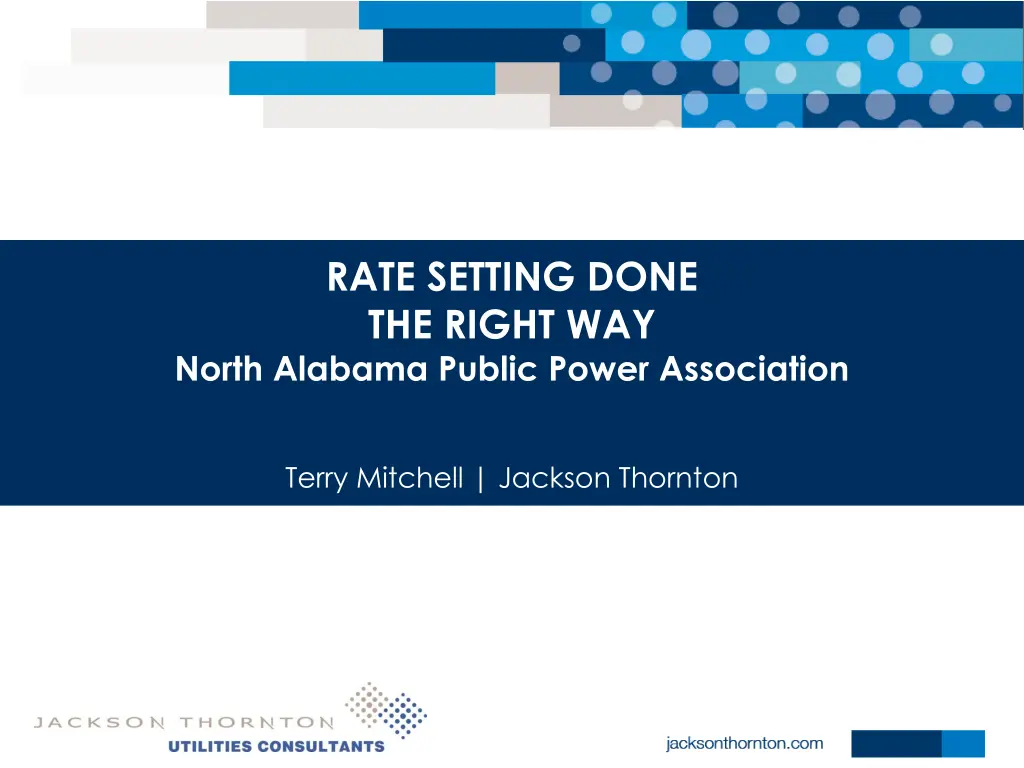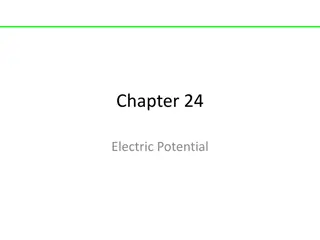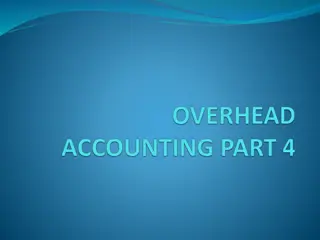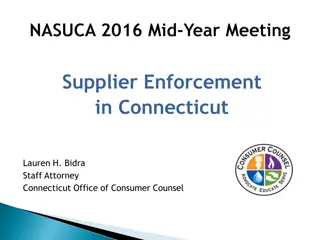
Setting Rates the Right Way in North Alabama
Explore the process of rate-setting by the North Alabama Public Power Association, featuring insights on governance structures, stakeholder considerations, and the fiduciary role of board members in managing rates for customers while ensuring financial sustainability. Understand the impact of regulatory agencies, community needs, and utility missions on the rate-setting process.
Download Presentation

Please find below an Image/Link to download the presentation.
The content on the website is provided AS IS for your information and personal use only. It may not be sold, licensed, or shared on other websites without obtaining consent from the author. If you encounter any issues during the download, it is possible that the publisher has removed the file from their server.
You are allowed to download the files provided on this website for personal or commercial use, subject to the condition that they are used lawfully. All files are the property of their respective owners.
The content on the website is provided AS IS for your information and personal use only. It may not be sold, licensed, or shared on other websites without obtaining consent from the author.
E N D
Presentation Transcript
RATE SETTING DONE THE RIGHT WAY North Alabama Public Power Association Terry Mitchell | Jackson Thornton
Disclaimer The information contained herein is general in nature and based on authorities that are subject to change. Jackson Thornton guarantees neither the accuracy nor completeness of any information and is not responsible for any errors or omissions, or for results obtained by others as a result of reliance upon such information. Jackson Thornton assumes no obligation to inform the reader of any changes in tax laws or other factors that could affect information contained herein. This publication does not, and is not intended to, provide legal, tax or accounting advice, and readers should consult their tax advisors concerning the application of tax laws to their particular situations. Circular 230 Disclosure This analysis is not tax advice and is not intended or written to be used, and cannot be used, for purposes of avoiding tax penalties that may be imposed on any taxpayer.
REGULATION OF PUBLIC POWER UTILITIES MUNIS COOPERATIVES 3
MUNIS BOARDS ARE EITHER ELECTED OR APPROVED BY ELECTED OFFICIALS 4
COOPERATIVES BOARDS ARE ELECTED ON ROTATING TERMS USUALLY BY DISTRICT 5
GOOD OR BAD? POLITICS COME INTO PLAY WHEN SETTING RATES 6
BOARDS SERVE DIFFERENT STAKEHOLDERS Regulatory Agencies Community BOARD Lenders City Government Employees Customer Utility 7
BOARD MEMBERS SERVE A FIDUCIARY ROLE MUST SERVE THE ROLE OF MANAGING RATES FOR CUSTOMERS MUST SERVE THE ROLE OF KEEPING UTILITY FINANCIALLY SELF-SUSTAINABLE 8
BOARDS ROLE IN RATE SETTING Customer Needs Financial Needs for Utility 9
Mission Statement Our Utility s mission is to provide the safest, most reliable and dependable source of energy to our customers at the lowest cost 10
BOARDS ROLE IN RATE SETTING Customer Needs Financial Needs for Utility 11
Financial needs of the Utility must be driven by financial policies and goals 12
Annual Revenue Requirements O & M (Budget) Power Cost (Financial/Power Requirements Forecast) Debt Service (Loan Covenants) Pilot/Capital Credits (Defined) CIP (Work Plan) **At Least Annual Depreciation Must develop financial goals and policies 13
Financial Policies and Goals Set guidelines that help determine revenue needs to make Utility financially self- sustainable (Take emotions out of Process) Provide Board and management with boundaries on important issues 14
Contd Helps to minimize politics on setting rates Reflects financial stability to lenders/bond holders Increase credit value Strengthens role as a valuable asset to your city/community 15
Financial Policies to Consider Rate Policies Financial Planning Policies Debt/Margin Policies Capital Funding Policies Reserve Funding Policies Financial Forecasting 16
Rate Policies Are rates set based on costs-to-serve? Do you have plans for annual inflationary increases? Try to avoid Rate Shock Time-sensitive rates Economic development rates Line extension policy 17
Financial Planning Policies Budgeting Policies Debt Coverage Requirements Margin/Equity Requirements Capital Project Funding Reserve Requirements Financial Forecasting Rate Stability 18
Use annual flow of funds to help guide financial policies 19
Why financial goals and policies are required/important Rate Agency Guidelines Very strong DSC (Avg. 5 yrs 5.2 times) Strong cash position History of taking rate action to meet financial needs 21
Steps To Take Meet with Board to assist in understanding and setting financial goals and policies Set periodic dates to examine goals and policies to determine their effectiveness Review your flow of funds statement to see if the financial goals and policies are meeting the financial needs of your Utility 22
Financial goals and policies can: Provide guides to set the financial needs (Annual Revenue Requirements) of your Utility Minimize the impact of politics on rates Make your Utility financially self-sustainable *Increase credit value Note: Most important to memorialize the financial goals and policies 23
QUESTIONS ??? W. Terry Mitchell, Principal Jackson Thornton Utilities Consultants Montgomery, Alabama 334.240.3647
Which is not a major component of the annual cash flow statement? Text a KEYWORD to 22333 or Submit responses at PollEv.com ANSWERS KEYWORD a. Cash flow from investing 297396 b. Cash flow from normal operations c. Cash flow from asset sales 297399 297407 d. Cash flow from financing 297408
How often should rates be adjusted? Text a KEYWORD to 22333 or Submit responses at PollEv.com ANSWERS KEYWORD a. When you build a new substation b. After an election 297438 297439 c. Annually with inflation 297447 d. When financial policies are going to be violated 297453






















